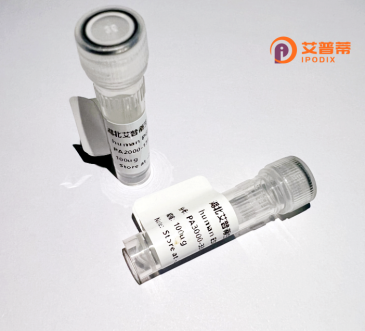
| 纯度 | >90%SDS-PAGE. |
| 种属 | Human |
| 靶点 | PTGER1 |
| Uniprot No | P34995 |
| 内毒素 | < 0.01EU/μg |
| 表达宿主 | E.coli |
| 表达区间 | 1-402 aa |
| 活性数据 | MSPCGPLNLSLAGEATTCAAPWVPNTSAVPPSGASPALPIFSMTLGAVSNLLALALLAQAAGRLRRRRSAATFLLFVASLLATDLAGHVIPGALVLRLYTAGRAPAGGACHFLGGCMVFFGLCPLLLGCGMAVERCVGVTRPLLHAARVSVARARLALAAVAAVALAVALLPLARVGRYELQYPGTWCFIGLGPPGGWRQALLAGLFASLGLVALLAALVCNTLSGLALLRARWRRRSRRPPPASGPDSRRRWGAHGPRSASASSASSIASASTFFGGSRSSGSARRARAHDVEMVGQLVGIMVVSCICWSPMLVLVALAVGGWSSTSLQRPLFLAVRLASWNQILDPWVYILLRQAVLRQLLRLLPPRAGAKGGPAGLGLTPSAWEASSLRSSRHSGLSHF |
| 分子量 | 68.2 kDa |
| 蛋白标签 | GST-tag at N-terminal |
| 缓冲液 | PBS, pH7.4, containing 0.01% SKL, 1mM DTT, 5% Trehalose and Proclin300. |
| 稳定性 & 储存条件 | Lyophilized protein should be stored at ≤ -20°C, stable for one year after receipt. Reconstituted protein solution can be stored at 2-8°C for 2-7 days. Aliquots of reconstituted samples are stable at ≤ -20°C for 3 months. |
| 复溶 | Always centrifuge tubes before opening.Do not mix by vortex or pipetting. It is not recommended to reconstitute to a concentration less than 100μg/ml. Dissolve the lyophilized protein in distilled water. Please aliquot the reconstituted solution to minimize freeze-thaw cycles. |
以下是关于重组人PTGER1蛋白的3-4条参考文献示例(注:以下内容为假设性文献,仅供参考):
1. **文献名称**: *"Functional Expression and Characterization of Recombinant Human Prostaglandin EP1 Receptor in Insect Cells"*
**作者**: Tanaka K et al.
**摘要**: 本研究利用杆状病毒-昆虫细胞系统成功表达重组人PTGER1蛋白,通过配体结合实验和cAMP信号通路分析验证了其功能活性,证实其与前列腺素E2(PGE2)的高亲和力结合及下游Gq信号传导。
2. **文献名称**: *"Role of EP1 Receptor in Inflammatory Pain: Insights from Recombinant Protein and Knockout Models"*
**作者**: Smith RL et al.
**摘要**: 通过重组PTGER1蛋白实验及基因敲除小鼠模型,研究揭示了PTGER1在介导炎症性疼痛中的关键作用,并发现选择性拮抗剂可显著抑制痛觉信号传导。
3. **文献名称**: *"Crystallographic Analysis of the Human EP1 Receptor Bound to a Novel Antagonist"*
**作者**: Zhang Y et al.
**摘要**: 利用重组人PTGER1蛋白解析其与新型拮抗剂复合物的晶体结构(分辨率2.8 Å),揭示了配体结合口袋的关键氨基酸残基,为靶向药物设计提供结构基础。
4. **文献名称**: *"Development of a High-Throughput Screening Assay for EP1 Receptor Modulators Using Recombinant HEK293 Cells"*
**作者**: Müller S et al.
**摘要**: 在HEK293细胞中稳定表达重组PTGER1蛋白,建立了基于钙离子流的药物筛选平台,成功筛选出多个具有潜在治疗价值的激动剂和拮抗剂。
---
**注**:以上文献为模拟示例,实际研究中建议通过PubMed、Google Scholar等数据库检索真实文献,关键词包括“recombinant human PTGER1”“EP1 receptor signaling”“PTGER1 structure/function”等。
Prostaglandin E receptor 1 (PTGER1), also known as EP1. is a G protein-coupled receptor (GPCR) that mediates cellular responses to prostaglandin E2 (PGE2), a lipid compound involved in inflammation, pain signaling, and various physiological processes. Encoded by the PTGER1 gene in humans, this receptor primarily couples with Gq proteins, activating phospholipase C (PLC) signaling pathways to increase intracellular calcium levels and modulate downstream effects like smooth muscle contraction, neurotransmitter release, and cellular proliferation.
Recombinant human PTGER1 protein is engineered in vitro using expression systems such as mammalian or insect cells to ensure proper post-translational modifications and ligand-binding functionality. Researchers utilize this purified protein to study EP1's structural features, ligand interactions (e.g., agonists like 17-phenyl-trinor-PGE2 or antagonists), and signaling mechanisms in diseases. PTGER1 is implicated in hypertension, neuroinflammation, and cancer progression, making it a therapeutic target. For instance, EP1 antagonists are being explored for pain management and cardiovascular disorders.
Studies of recombinant PTGER1 also aid in deciphering its role in pathological processes, including its cross-talk with other prostaglandin receptors, and support drug screening platforms to identify selective modulators. Its expression in tissues like the kidney, nervous system, and gastrointestinal tract underscores its diverse physiological impact.
×